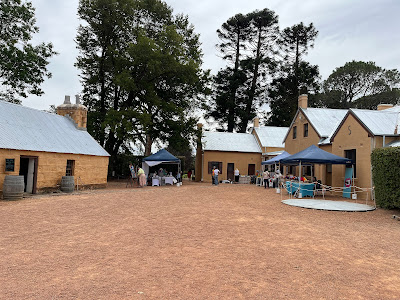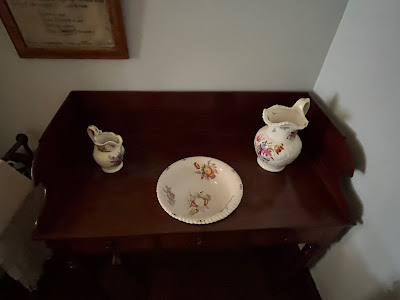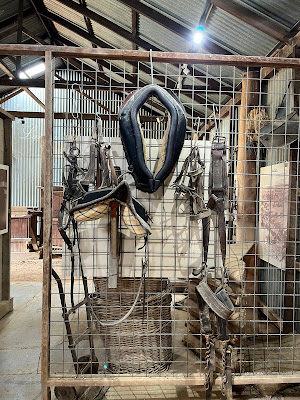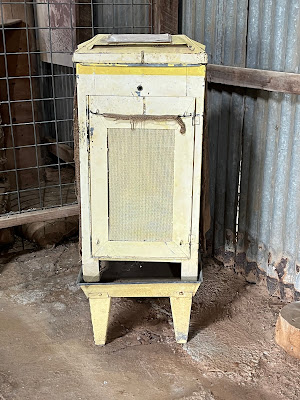As you may know, if you read my other blog, I visited Lanyon Homestead for some hop-picking a couple of months ago. While there, we toured the inside of the house, and it was pretty cool. I really enjoyed the decor and the history. Here is some of it, taken mainly from the brochure on the website.
I like the way they have presented the site, not as thing entirely preserved in a frozen moment, but more as a continuum, to show, as the quote from English historian Jack Ravensdale makes clear, that 'the house (the land and the farm buildings) has a history not a date.' Hence, inside the homestead visitors readily accept the distinct time zones. Thus the mid-Victorian hall leads into the late-nineteenth-century station office, then into the Edwardian extension. Nearby are the mid-twentieth century bathrooms and the slightly later kitchen and upstairs bedrooms. These rooms illustrate a process of continuous adaptation and change which is familiar to all.
The land was purchased by James Wright and John Lanyon in 1834, and then John Lanyon returned to England leaving James Wright to manage the property alone. He honoured his friend by naming the property Lanyon.
Convicts were assigned to work on the property in return for rations, clothing and simple wooden huts, and with their labour, James established a home farm to provide food, built a small house for the convicts, and a kitchen and barn, both of which still stand today.
Andrew and Jane Cunningham bought Lanyon in 1849. They built a new homestead alongside the existing house, which was later demolished. By the 1860s the region was becoming less isolated as more land had been settled and homes established. The Cunninghams were "comfortable without being affluent, and the house and furnishings reflected this".
Brothers James and Andrew Jackson Cunningham inherited Lanyon on the death of their father in 1887. They ran it in partnership, Andrew living at Lanyon and James at Tuggeranong. 1905 saw dramatic change at Lanyon when Andrew married Louisa Leman, 30 years his junior. The homestead almost doubled in size and was completely redecorated in contemporary Edwardian style.
 |
| Four poster bed complete with straw mattress. |
When Andrew died childless in 1913 Louisa sold the contents of the house and moved to Sydney. James and Mary Cunningham and their family moved to Lanyon, making it their home for the next thirteen years. Lanyon's hospitality and comfort during the Cunningham's ownership was well known and, although the house has received additions and minor modifications over the past hundred years, its architectural detail remains unchanged.
A mid-nineteenth century colonial drawing room with its central table, case covered furniture, and hand-blocked wallpapers had its counterpart in provincial England. The Lanyon drawing room of the nineteenth century was described as being decorated in soft golds.
Colonial dining rooms mirrored English examples and were furnished in sombre tones. The decoration of the table, the positioning and dressing of the epergnes and vases, even the folding of napkins, were treated with the utmost seriousness. An Australian cookbook of 1861 advises that 'the napkins used at dinner, breakfast, and at all meals are not only essentially necessary [unlike that adjective], but they add materially to the appearance of the table. The fold is a matter of taste. The French model is to place them in the shape of a fan, while the English custom is to form them as a shoe, placing the bread inside, the most desirable way. Good light, moderate temperature, snow white linen, clean plate and beautiful glass are necessary appendage to the dinner table'.
During and after World War One, the family spent an increasing amount of time away from the property. The enlistment of local men also left the workforce depleted. The property was sold in 1926 to Harry Osborne and again in 1930 to Thomas Field.
Entrance halls are important because they provide instant clues to the way their owners wish to be regarded. To recreate a nineteenth-century entrance hall at Lanyon, fitted modern carpets were replaced by a hand-painted floor cloth, the walls were painstakingly peeled back to reveal a faux stone decorative finish, and the original floorboards were polished to a golden glow.
My favourite room is the study/ office with its display of wool categorisation and eclectic pipe collection.
Replica wallpapers, floor coverings and furnishing fabrics, combined with nineteenth century Australian and European furniture, and a philosophy firmly embedded in common sense room use, recreate the style of rooms which the Cunninghams may have enjoyed.


















































No comments:
Post a Comment